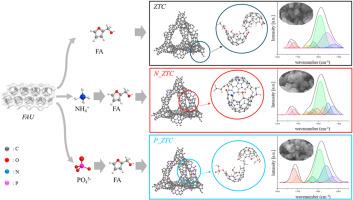Spectroscopic characterization of black N- and P-doped zeolite templated carbons
IF 4.8
3区 材料科学
Q1 CHEMISTRY, APPLIED
引用次数: 0
Abstract
The incorporation of heteroatoms (X) into the zeolite-templated carbon (ZTC) structure is a widely used technique to tailor its properties for specific applications such as gas adsorption, methane and hydrogen storage, and catalysis. However, the literature lacks sufficient data on Fourier-transform infrared spectroscopy (FTIR) analysis of ZTCs due to the challenge in obtaining high-quality FTIR spectra required for accurate assignment of the C–X bands, primarily caused by the black mass effect. In this work we prepared nitrogen (N) and phosphorus (P) doped ZTC samples using FAU type zeolite as a template and furfuryl alcohol as a carbon precursor. The Raman results confirmed the presence of medium-sized aromatic structures and also showed that doping these structures with N and P leads to some defects, although the overall conformation remains structurally intact. The FTIR spectra of the ZTC materials were obtained by controlling the preparation procedure and humidity, enabling clear analysis of the black samples. A Density Functional Theory (DFT) model based on the dimeric buckybowl structure was developed and complemented by experimental results obtained from X-ray photoelectron spectroscopy (XPS), nuclear magnetic resonance (NMR), and FTIR. The proposed DFT model was then used for deconvolution and precise band assignment of the experimental FTIR spectra. The FTIR deconvolution study also supported the incorporation of N and P into the ZTC as well as the presence of primarily two types of nitrogen species, amide (primary and secondary) and pyridine-like, while P was mainly incorporated as triphenylphosphine oxide and phosphonic acid.

掺杂 N 和 P 的黑色沸石模板碳的光谱表征
在沸石模板碳(ZTC)结构中加入杂原子(X)是一种广泛使用的技术,可针对气体吸附、甲烷和氢气存储以及催化等特定应用调整其特性。然而,由于难以获得准确分配 C-X 波段所需的高质量傅立叶变换红外光谱(FTIR),文献中缺乏有关 ZTC 的傅立叶变换红外光谱(FTIR)分析的充足数据,这主要是由黑质效应引起的。在这项工作中,我们以 FAU 型沸石为模板,以糠醇为碳前驱体,制备了掺氮(N)和掺磷(P)的 ZTC 样品。拉曼结果证实了中等大小芳香结构的存在,同时还表明,在这些结构中掺入氮和磷会导致一些缺陷,尽管整体构象在结构上保持完整。通过控制制备过程和湿度,获得了 ZTC 材料的傅立叶变换红外光谱,从而能够对黑色样品进行清晰的分析。基于二聚降压钵结构建立了密度泛函理论(DFT)模型,并通过 X 射线光电子能谱(XPS)、核磁共振(NMR)和傅立叶变换红外光谱获得的实验结果对该模型进行了补充。提出的 DFT 模型随后被用于傅立叶变换红外光谱实验的解卷积和精确波段分配。傅立叶变换红外光谱解卷积研究还证实了氮和磷在 ZTC 中的掺入,以及主要存在两类氮,即酰胺(伯和仲)和类吡啶,而磷主要以氧化三苯基膦和膦酸的形式掺入。
本文章由计算机程序翻译,如有差异,请以英文原文为准。
求助全文
约1分钟内获得全文
求助全文
来源期刊

Microporous and Mesoporous Materials
化学-材料科学:综合
CiteScore
10.70
自引率
5.80%
发文量
649
审稿时长
26 days
期刊介绍:
Microporous and Mesoporous Materials covers novel and significant aspects of porous solids classified as either microporous (pore size up to 2 nm) or mesoporous (pore size 2 to 50 nm). The porosity should have a specific impact on the material properties or application. Typical examples are zeolites and zeolite-like materials, pillared materials, clathrasils and clathrates, carbon molecular sieves, ordered mesoporous materials, organic/inorganic porous hybrid materials, or porous metal oxides. Both natural and synthetic porous materials are within the scope of the journal.
Topics which are particularly of interest include:
All aspects of natural microporous and mesoporous solids
The synthesis of crystalline or amorphous porous materials
The physico-chemical characterization of microporous and mesoporous solids, especially spectroscopic and microscopic
The modification of microporous and mesoporous solids, for example by ion exchange or solid-state reactions
All topics related to diffusion of mobile species in the pores of microporous and mesoporous materials
Adsorption (and other separation techniques) using microporous or mesoporous adsorbents
Catalysis by microporous and mesoporous materials
Host/guest interactions
Theoretical chemistry and modelling of host/guest interactions
All topics related to the application of microporous and mesoporous materials in industrial catalysis, separation technology, environmental protection, electrochemistry, membranes, sensors, optical devices, etc.
 求助内容:
求助内容: 应助结果提醒方式:
应助结果提醒方式:


